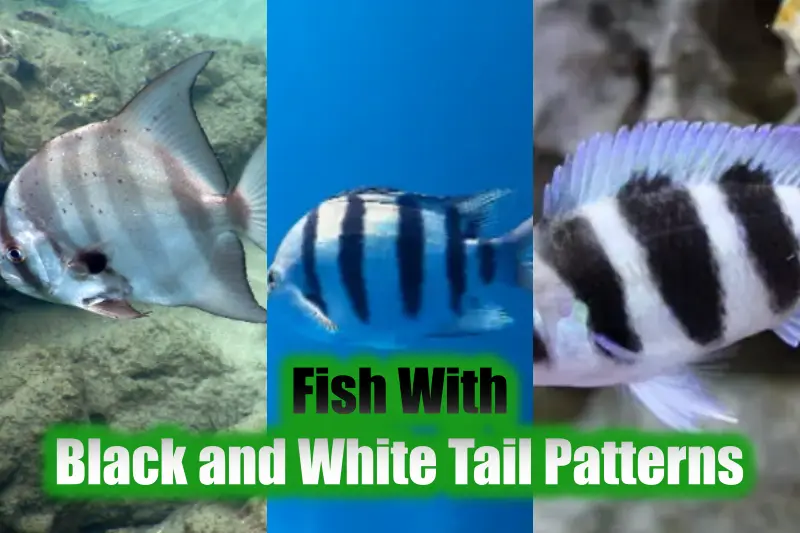The underwater realm of fishes is a fascinating place. From tiny guppies to the largest whale sharks, the underwater world consists of a wide array of these creatures. These inhabitants not only add vibrant colors to the deep oceans, but they also play an important role in maintaining ecosystem balance.
Here are the top ten most beautiful fish with striking black and white tail patterns. So, all you fish enthusiasts and underwater explorers, get ready for an adventure because we have for you a well-researched list of fish that sport the timeless combination of black and white tails.
Are you excited to join us on this journey into the world of different fish groups? (By the way, when many fish gather, it’s called a “school.”)
10 Fish With Black and White Tail Patterns
1) Old Wife
| Scientific Name | Enoplosus armatus |
| Size | 50 cm |
| Location | Australia |
| Diet | Scallops, shrimp, marine fish, and dried algae |
These beautiful fish are distinguished by their silver and black vertical zebra-like stripes all over their bodies. They are the only modern species in the family Enoplosidae.
Another distinguishing feature is their unusually deep and compressed bodies and concave foreheads. Their second dorsal fin is longer and sickle-shaped.
They have no apparent venom gland, but when stung by the spikey fins, they inflict a painful venom. Interestingly, they get their common name – Old Wife, from the sound of grinding teeth they make when caught.
2) Atlantic spadefish

| Scientific Name | Chaetodipterus faber |
| Size | 91 cm |
| Location | Western Atlantic Ocean |
| Diet | Small invertebrates like mollusks, annelids, and sometimes planktons |
Their bodies are silver, with 4-6 black stripes appearing on each side, which gradually fade with age.
The adults have a long, trailing anterior, giving them an “angelfish-like” appearance.
They inhabit marine and brackish water, typically in subtropical climates, appearing commonly in shallow waters along coastlines.
Though they have little commercial value, they are often regarded as game fish’ for their ability to put up a strong fight.
3) Whitetail dascyllus
| Scientific Name | Dascyllus aruanus |
| Size | 10 cm |
| Location | Indo-pacific regions and the Red Sea |
| Diet | Crustaceans, seaweeds, and benthic organisms |
They stand out due to their striking appearance. It has a white body with three bold black vertical bars that form a unique black-and-white pattern.
They prefer to live in association with coral reefs, often forming groups above Acropora coral heads.
In aquaculture, the whitetail dascyllus is known as an aquarium starter fish. It tolerates varying conditions and helps condition the tank environment for less hardy fish.
While they can be territorial with other fish, they’re also quite aggressive as adults. This makes them an interesting choice for aquarium enthusiasts looking to create a balanced tank ecosystem.
4) Moonlighter
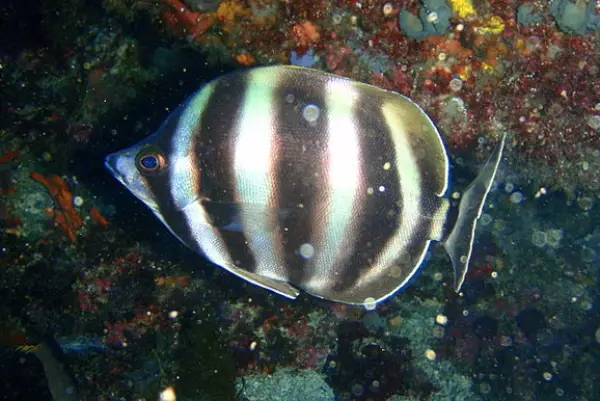
| Scientific Name | Tilodon sexfasciatus |
| Size | 40 cm |
| Location | Australia |
| Diet | Feed on algae and a variety of small invertebrates |
They have a silvery-white body adorned with prominent black vertical bands running throughout their body.
This body structure is strongly compressed and is characterised by a shallow caudal peduncle. The head is relatively small, with a slightly conical snout and large eyes.
Juvenile moonlighters prefer shallow rocky reefs as their habitat, while adults are often found on deeper coastal reefs.
They are known to have atypical behavior in cleaning, where they assist in removing parasites from other fish.
5) Ocellaris clownfish

| Scientific Name | Amphiprion ocellaris |
| Size | 8 cm |
| Location | Indo-Pacific regions |
| Diet | Crustaceans, algae, polychaete worms |
Also known as Black Percula for their very distinct jet-black bodies and three white stripes on each side with gray/orange iris.
Found as an association with anemones on the reef, as they have a symbiotic relationship with them, where anemones provide them with protection in exchange for food.
They are protandrous hermaphrodites, meaning the male can transition to a female during its lifetime.
Their popularity as eye-catching aquarium fish has resulted in a drastic decrease in their population.
6) Square back butterflyfish
| Scientific Name | Chelmonops curiosus |
| Size | 26 cm |
| Location | Australia |
| Diet | Small worms, crustaceans, and algae |
They feature four vertical black bars on their bodies, each outlined with silver edges. These bars become broader towards the tail, creating a distinct appearance.
They have a deep and strongly compressed body with a small head and a long, tapered snout, housing a tiny mouth at the tip.
They are known to use man-made structures such as pylons and jetties as part of their habitat.
Juvenile truncate coralfish are often spotted among seaweed beds, while adults are commonly observed in pairs.
7) Banded butterflyfish
| Scientific Name | Chaetodon striatus |
| Size | 16 cm |
| Location | Atlantic Oceans, the United States, and Brazil |
| Diet | Feeds on small invertebrates, crustaceans, coral polyps, and plankton. |
They have dark vertical bands running along their white bodies, combined with a vertical black bar through their eyes.
These markings aren’t just for looks; they help the fish hide from predators by making it hard to tell where its body ends and its surroundings begin.
Often seen either singly, in pairs, or sometimes in small groups of about twenty individuals.
Like the moonlighter, they also act as cleaning fish, removing external parasites from other fish species.
8) Scissortail sergeant
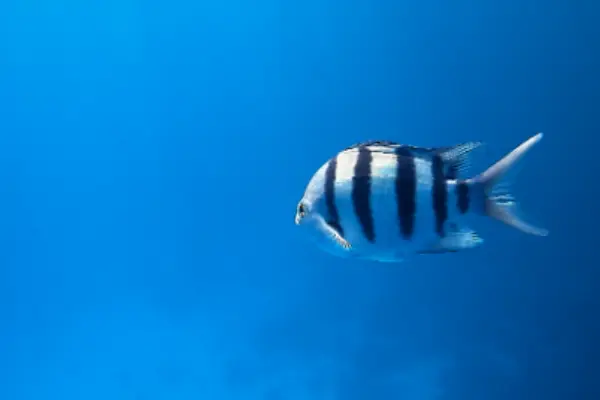
| Scientific Name | Abudefduf sexfasciatus |
| Size | 16 cm |
| Location | Red Sea, Indian Ocean, and Australia |
| Diet | Larvae of invertebrates, zooplankton, smaller fishes, crustaceans, and algae |
Their name comes from the intriguing black-striped tail and sides, which bear a striking resemblance to the markings of a military sergeant.
Their bodies are deep and compressed, indicating their adaptation to their coral reef habitat.
They are often seen forming groups that encircle a single coral head.
Male scissortail sergeants play a prominent role in parenting, guarding, and caring for the eggs until they hatch.
9) Front cichlid
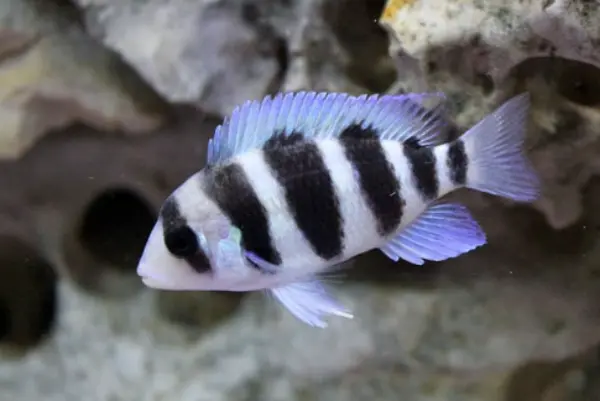
| Scientific Name | Cyphotilapia frontosa |
| Size | 33 cm |
| Location | Lake Tanganyika |
| Diet | Shrimps, krill, prawns, earthworms, and small fishes |
They have five to seven vertical black bars that contrast against a white or blue background. This unique pattern extends from their body to their head and trailing fins.
Mature Cichlid showcases a nuchal hump. This hump, more pronounced in older individuals, contributes to their characteristic appearance. The males often have a more distinct and larger hump.
They exhibit an interesting behavior of rising to shallower waters in the early morning; this helps to maintain an ecological balance.
When kept in aquariums, they must be kept between 25 and 30 degrees.
10) Convict surgeonfish
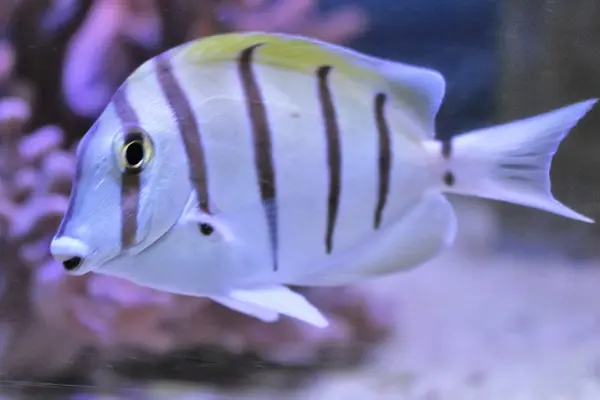
| Scientific Name | Acanthurus triostegus |
| Size | 17 -27 cm |
| Location | Indo-Pacific region, East African coast, Japan, Australia, and Central America |
| Diet | Algae |
Their bold black stripes running along the creamy-white body give them their name, “convict tang.”
They have an oval-shaped body that is laterally compressed, a pointed snout, and a terminal mouth with thick lips.
Juveniles often inhabit tide pools, while adults can be found at greater depths.
Conclusion
Nature and its mysteries can never be fathomed; this is our effort to slowly dig deeper and see what the world has to offer. With this article, we aim to provide the readers with concise information about the most exquisite black-and-white-tailed fish found underwater.
Also Read:

Hi everyone, my name is Shawna, and I’ve always been fascinated by the fascinating diversity of flora and fauna that our nature has in it. I am currently studying biotechnology and am particularly interested in animal biotechnology, delving into the intricate processes that define their true nature and uniqueness.
